33 Men (24 page)
Authors: Jonathan Franklin

A Word on Translation
Chilean Spanish is notoriously rich in slang. Miner lingo is notoriously rich in obscenities. The combination of those two realities made a literal translation virtually impossible. In many cases the Spanish used by miners and rescue workers, families and politicians has been translated to preserve the essence and meaning. Many obscenities have been simply removed not because of any particular offense, but due to the simple fact that they do not make sense in other languages. The author and publisher have maintained the intent of the words but allowed for a more coherent translation style. Given the use of multiple translators, there are likely to be minor differences of opinion in how best to present the rich texture of Chilean Spanish to a global audience.
A Word on Dates and Hours
This book is based on interviews with approximately 120 different participants in the rescue, including a majority of the miners, President Piñera and leading designers and participants. Due to the extraordinary nature of their underground confinement and the monotony of confinement, the miners were not always able to confirm the exact time and date of certain events. With no daylight or darkness to mark the passage of time, such confusion is understandable.
The author has sought to make sense of this confusion and understands it well as he personally went for one eight-day stretch without changing clothes, showering or even taking off his boots. Fatigue and exhaustion were in abundant supply for the last twenty days of the rescue. The author wishes to stress that despite repeated efforts to clarify certain sequences, discrepancies continue to exist among the very participants. Such is the nature of dramatic events.
Exclusive Access
Many of the scenes and interviews in this book were not available to the thousands of journalists at Camp Hope. Early in the rescue effort I reported from behind the police lines like the other reporters. As I realized the scope and drama of the operation, I asked the Asociación Chilena de Seguridad (ACHS), the insurance company in charge of much of the rescue operation, for permission to document their remarkable rescue efforts. I was covering the drama for numerous media including the
Washington Post
and
The Guardian
. The ACHS immediately agreed and provided me with a half-day tour of the rescue operation. They then told me the tour was over.
I
asked
to
stay
on
and
continue
to
report.
In
that
case,
I
was
told,
I
would
need
a
Rescue
Team
credential.
I
filled
out
the
forms,
wrote
that
I
was
a
writer
and
was
given
pass
No.
204.
For
much
of
the
ensuing
six
weeks
I
was
able
to
roam
the
front
rows
of
the
rescue
as
I
reported,
recorded
and
filmed.
At
no
time
did
I
suggest
that
I
was
on
any
other
mission
than
full-time
reporter.
The Oakley Sunglasses
In
accordance
with
full
disclosure,
I
am
proud
to
say
that
I
was
responsible
for
the
miners
receiving
Oakley
sunglasses.
During
a
planning
meeting
between
Codelco
and
the
Chilean
Navy
early
in
September,
it
became
apparent
that
the
miners
needed
high-quality
eyewear
upon
leaving
the
mine.
Given
the
overwhelming
logistics
of
planning
the
rescue,
the
officials
were
swamped
with
tasks
and
a
bit
lost
on
what
to
do
about
sunglasses.
Seven
years
earlier,
I
had
met
Erik
Poston,
an
Oakley
representative.
I
still
had
his
business
card.
I
wrote
Oakley
an
email
suggesting
they
send
thirty-five
pairs
of
sunglasses
(two
spares)
to
the
Chilean
rescue
team.
They
complied
and
the
rest
is
history.
In writing this book in the immediate aftermath of the mining drama, I found the challenges were numerous, the sacrifices many. First I would like to thank my wife, Toty Garfe, for accepting my months-long disappearing act. And to my daughters Kimberly and Amy, sorry to have missed your birthday. Zoe, your baptism photos are great; it would have been better to have been there. Susan, congratulations on winning so many high-diving medals; I saw the video. Maciel, how did you grow half a foot in two months? Francisca, my first daughter, your loyalty to your globe-trotting dad is appreciated.
To Annabel Merullo, Caroline Michel, Juliet Mushens, Alexandra Cliff and the team at PFD, you were the first to see the potential of this book and guided it through the Frankfurt Book Fair and to higher ground. I am forever grateful. George Lucas of Inkwell Management, you guided this book through the jungles of U.S. publishing and landed me at Putnam, where Marysue Rucci and Marilyn Ducksworth were instrumental in turning this book into a beautifully designed, finely edited and nationally known work. Both Diana Lulek and Michelle Malonzo at Putnam dropped their schedules to answer my many questions about publishing my first book. At Putnam I would also like to thank the managing editorial team of Meredith Dros and Lisa D'Agostino, who were busier than air traffic control at JFK, keeping all the pieces of this project in sync. And to Putnam President Ivan Held for his backing of my first book: I appreciate your unwavering support. Finally, I want to thank Art Director Claire Vaccaro, who patiently figured out the maps and photos, and Copy Chief Linda Rosenberg, who worked through the holidays. To Bill Scott-Kerr and Simon Thorogood at Transworld Publishing in London, your early support for this project was key to making it happen. Bob Bookman and the team at CAA for everlasting optimism inside the madness that is Hollywood movie production. To Colin Baden, Diane Thibert, and Rachel Mooers at Oakley for a generous contribution to the miners. Thanks to MartÃn Fruns, Alejandro Piño and the entire medical and psychological staff at the ACHS for their professional treatment and constant help throughout this project. A special mention of psychologist Alberto Iturra, who may have had the hardest job of allâkeeping the miners united underground. Alberto, the miners may not have realized how hard your job was, but the rest of us did!
My father, Tom Franklin, used to fact-check and copyedit my third-grade homeworkâsee, it all paid off! My older sister Sarah, who is a tremendous writer and even greater inspiration, cleared the way for my career. My younger brother Christopher, who silently creates parks and recreation areas, your legacy is already here. To my mother, Susan, who is watching from above, you not only delivered me to this world but imbued me with a spirit of survival and endurance.
To my colleagues, including Dean Kuipers,
L.A. Times
, early investor in my self-confidence. Sam Logan, of SouthernPulse, a visionary journalist. Denise Witzig, Brown University, a key mentor. John Kifner,
New York Times
, early mentor. Hunter S. Thompson, no explanation needed! Michael Smith, Bloomberg, best investigative reporter I know. Jorge Molina,
El Mostrador,
Chile's finest reporter. Pablo Iturbe and Tim Delhaes, Tigabytes, close conspirators and fellow dreamers. Rory Carroll, Martin Hodgson, David Munk, Marx Rice Oxley and the entire foreign desk at
The Guardian
for putting up with my random acts of generosity. Tiffany Harness, Doug Jehl Griff Witte and Juan Forero at the
Washington Post
, who proved that great editors still exist. Guillermo Galdos, Discovery Channel, for hosting me at the San José mine and always providing inspiration. Lonzo Cook and Karl Penhaul of CNN for good humor and great dinners. Amaro Gómez-Pablos Benavides of Televisión Nacional de Chile, for loyalty and laughs. Francisco Peregil from
El Pais
, an example that great journalism can also be collaborative. Bert Rudman, John Quinones, Joe Goldman and the whole ABC News team, who took me under their wing at Camp Hope. Carlos Pedroza and Manuel Martinez of
Esquire Mexico
for their long-term loyalty and eye for real news, Miguel Soffia for proving that the next generation is going to make us old-timers feel slow and lazy! And finally to James Bandler, my eternal co-conspirator, master of the understatement and the world scoop and the reason I went to Chile twenty-one years ago.
And to the thirty-three minersâeach of whom took time to speak with me and provide information for the book. In particular I would like to thank Mario Sepúlveda, Raúl Bustos, Alex Vega, Juan Illanes and Samuel Ãvalos.
Finally my business partner Morten Anderson, for his patience during my unexpected sabbatical. Assistants Gemma Dunn, Lucia Bird and Ellen Jones were infinitely patient in transcribing Chilean miner interviews from an almost unintelligible slang into perfect English.
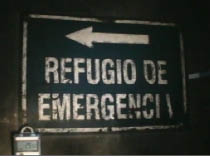
Inside the San José mine, a sign points in the direction of the safety shelter where the men gathered after the August 5 collapse.
REUTERS / Chilean Mining Ministry / Landov
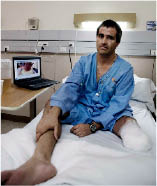
Miner Gino Cortés had his leg sliced off by falling rock inside the San José mine just days before the August 5 collapse.
© Morten Anderson
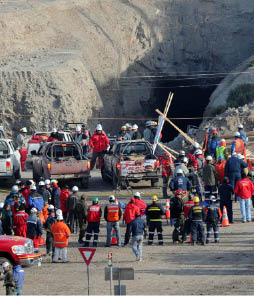
The mouth of the mine.
MARTIN BERNETTI / AFP /
Getty Images
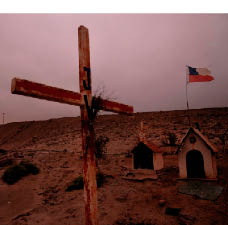
Desert shrines to sudden deaths along the Atacama Highway.
Ariel Caliban Marinkovic

Every morning a tongue of thick fog engulfed the valley in a blanket of cold, mysterious air.
Associated Press /
Natacha Pisarenko
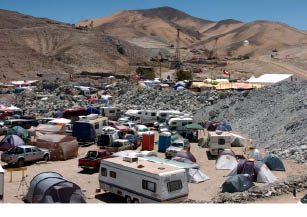
Campers, cranes and Camp Hopeâan empty corner of the Atacama Desert filled up overnight.
Associated Press / Carlos Espinosa

Dozens of children made Camp Hope their home as anguished parents awaited the rescue.
ARIEL MARINKOVIC / AFP / Getty Images
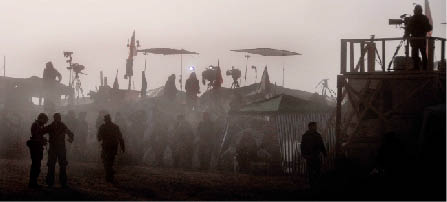
The morning fog hid the antenna trucks and the media frenzy.
Ariel Caliban Marinkovic

Thirty-three candles for the minersâa singular shrine built into the side of the rocky hillside.
ARIEL MARINKOVIC / AFP /
Getty Images
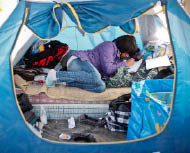
Inside a tent at Camp Hope, a family member curls up to write a letter to one of the trapped miners.
© Ronald Patrick

Tears and emotions were stretched to the limit as rescuers pushed forward in search of the trapped men.
© Ronald Patrick
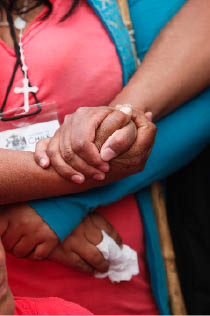
Solidarity at Camp Hope as family members united to push rescuers to never give up.
© Ronald Patrick
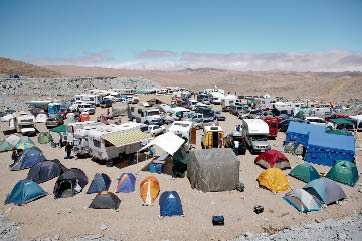
An estimated three thousand journalists flocked to the San José mine, living in an instant tent city that stretched for acres.
© Ronald Patrick
